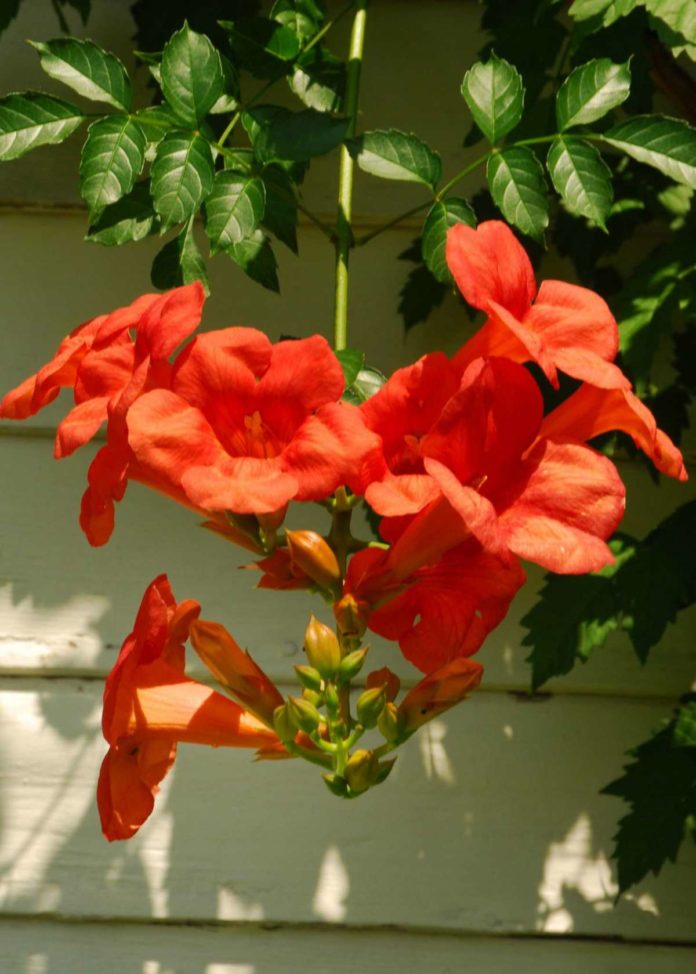Q: This is what I’m seeing with my loquat tree. I have removed all of the dead leaves that I can, but now I’m seeing these massive amounts of bark splitting and falling off. What does this suggest for the future of my tree?
A: Bark is a critical tissue in conducting sugars from the leaves back down to the roots. Just inside the bark is a tissue called phloem. It’s in that cylinder of conducting tissue that the sugars are transported. When the bark is lost, the supply line is lost.
Therefore, I’m very concerned about the long-term hopes for your tree. I suspect that you will end up needing to replace it. I’m sorry for the nature of my answer.
Q: If three of my Italian cypress trees have some green branches within them, is there hope for the plants if I trim out the brown branches?
A: That depends on what caused the browning. Some Italian cypress trees were killed by the cold, and that damage will continue to get worse now that they’re under the stress of summer.
Others are affected by Seiridium canker. That is a disease for which we have no prevention nor cure. So, it doesn’t sound like there’s a lot more hope for Italian cypress with that problem, either.
Spider mites are also an issue, and they show up earlier on conifers than mites do on other plants. Whether plants would come back from spider mite damage or not would really depend on the extent of the damage. You would need to determine for certain whether spider mites were indeed involved.

This is Madame Galen trumpetcreeper.
Courtesy photo
Q: We have a very large trumpet vine covered in seed pods. Can I grow another trumpet vine from these pods?
A: Yes, if you leave them on the plant until they are mature and the seeds are ripe. However, are you really sure you want to? Trumpet vines are incredibly invasive, sending up root sprouts all over the yard.
The much more refined variety called Madame Galen trumpetcreeper would be a far better choice. It would be my only choice in an orange trumpet vine.

If your mountain laurel starts sprouting like this as it recovers from the freeze, don’t worry. Those shoots are not taking up that much energy from the rest of the tree.
Courtesy photo
Q: As we continue to wait for our plants to recover from the freeze, we see this kind of growth on Texas mountain laurels (see photo). Should we remove all of these shoots and let the plant push all of its energy to the tip growth, or should we let them develop?
A: Let them develop. They’re not going to be stealing that much away from the tips, and you probably want the plants to fill in anyway.
Q: Do you think the hedge in the attached photos can be salvaged? I would rather not have to replace all of it.
A: I was not able to separate the photos in your PDF sheet. It appears to be Japanese boxwood, and it looks like the backside 80 percent has died.
Unfortunately, I think it would take a long time for these five or six plants to fill back in again. As little as these cost, you would be far better off replacing them.
Since they are below low windows, I would suggest that you consider dwarf yaupon hollies, dwarf Chinese hollies or Carissa hollies. All would be more spreading and more easily maintained, also more durable.
Q: I have a golden rain tree that has not sprouted a single leaf yet this year. I love this tree, but by now it should be growing vigorously. Is there any chance it will come back normally?
A: It sounds like you have Chinese flame tree (Koelreuteria bipinnata), sometimes called southern golden rain tree. It produces the pink seed pods that mature in the fall. It is subtropical and is much less winter hardy than its northern counterpart (K. paniculata). I’m going to guess that it has frozen and will not come back.

This live oak has a root girdling issue.
Courtesy photo
Q: Attached is a photo of our live oak. This appears to be a problem of girdling roots. How would I find a list of arborists capable of helping with this problem?
A: If you go to the website of the International Society of Arboriculture, isa-arbor.com, you will find a way of submitting your ZIP code to find an arborist in your area. I will warn you that it will also list arborists who work for corporations and who teach at universities. But if you keep sorting, that is the official way to find a certified arborist.
Good independent retail garden centers will know the best ones in your area. Looking at your photo, this looks like something that you could eliminate with a small pruning saw, a chisel, a mallet and some time and patience. You just need to get rid of the encircling root pieces.

This is rabbit damage to Carissa hollies.
Courtesy photo
Q: After the freeze took out our Indian hawthorns, we replaced them with Carissa hollies because we heard they are almost indestructible. Recently, we have seen this damage. Does it appear that something has been eating them?
A: Yes. Almost assuredly rabbits have visited your plants. I helped our son replace his Indian hawthorns with dwarf Burford hollies, and their plants have been stripped by the rabbits. He has erected cages of chicken wire temporarily around them until the plants can develop leathery, mature foliage later in the summer. This is the most damage I have seen rabbits do to hollies.
Mail questions to Neil Sperry, c/o Features Department, San Antonio Express-News, P.O. Box 2171, San Antonio, TX 78297-2171, or email him at SAENgardenQA@sperrygardens.com.









